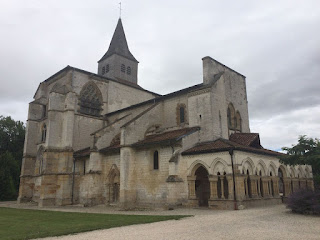By about 11 am we were tied up in the moorings in Bar-le-Duc. A couple of pontoons and a long bank with a few bollards is right next to a popular camping car spot and it seemed like right in the train station. We were so close we could hear the familiar 4 tones that precede the arrival and departure announcements. Luckily there’s not too much traffic at night and since it’s going through a busy station, it’s going slow. There is supposed to be a very small charge for tying up and a little more for water and electricity but the collection was sporadic. We think somebody was on vacation, like everybody else in France in August. Finding an open restaurant can be a trial.
As with most of the towns in the area, Bar began at a Roman crossroads on the Ornain River but didn’t grow to it’s real importance and gain defensive walls (and the upper town) until the mid 900’s. It escaped WW I with little damage but was an important logistics center for the battles taking place around Verdun.
Bar-le-Duc is two towns, the lower and the upper. The lower town consists of mostly shops and restaurants and the upper town contains the restored old quarters with its mansions, museums and the clock tower. The Ornain runs through the lower town and is crossed by the picturesque Notre Dame bridge.
Martin would be leaving for Paris on Saturday so we had all of Thursday afternoon and Friday to explore the town. That meant climbing the stairs to get up to the upper town and that clock tower.
Across the river and canal and up behind Cathy Jo and her father on the stairs, The Côte Sainte-Catherine district sits on the hill. Built in response to the post WW II baby boom of the 1960’s and replacing vineyards decimated by the phylloxera pest, the massive residential project was constructed using the egalitarian housing ideas of Le Corbusier.
The upper town sits on a ridge and the old buildings spill down the other side.
One of the more impressive structures of the upper town is the Eglise Saint-Ètienne.
It contains one of the more, um, interesting sculptures we’ve seen on our travels. Renè of Chalon, the Prince of Orange, was killed in the siege of Saint-Dizier in 1544. In 1547, his wife commissioned a statue from Ligier Richier, a prominent artist, to depict what her late husband would like three years after his death. The result is just a little macabre.
The town is also famous as the home of Pierre Michaux. A monument on a lower town street corner honors the inventor of the bicycle. While repairing a draisienne, a sort of bicycle without pedals, he decided to add a crank and by 1862 his company was turning out 200 bicycles a day.
During our stay in Bar we also got in touch with Duncan Flack, the operator of Lorraine Marine where Oldtimer will be spending the winter. He operates a “breakdown” service and made the hour-long drive from Toul to Bar-le-Duc on Friday to bring us a new throttle cable. All was made like new.
Saturday morning Martin set off on his trip to Paris and we made preparations for the final leg our our 2017 journey; over the top of the western branch of the Canal de la Marne au Rhin, including the 5 k long Mauvages tunnel, and on to Toul.
























